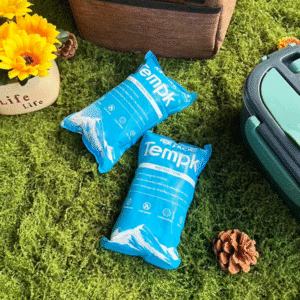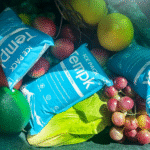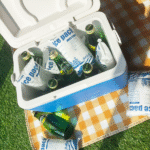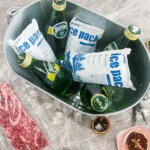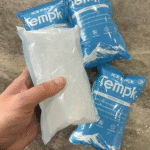Shipping temperature sensitive products in insulated boxes and dry ice packs requires careful planning. You need the right packaging, the correct amount of dry ice, and a clear understanding of safety and regulatory guidelines. الجليد الجاف is much colder than water based ice and sublimates into gas, so your insulation and venting must be appropriate. According to industry guidance, the amount of dry ice needed depends on shipment duration: على سبيل المثال, equal weight of dry ice and product can maintain frozen temperatures for up to 48 ساعات. في 2025 the cold chain industry is adopting new technologies like smart sensors and hybrid insulation, making it easier to maintain temperature integrity while reducing environmental impact. This guide offers a practical roadmap to help you ship perishables confidently.
How do insulated boxes and dry ice packs work together to keep goods frozen? We explain insulation materials, dry ice chemistry and the advantages of combining them.
How do you choose the right packaging and calculate the right amount of dry ice? Learn simple rules of thumb for different payload weights and transit times.
What safety and regulatory requirements apply in 2025? Understand labeling requirements, hazardous material rules and airline weight limits.
What are the latest trends and innovations in cold chain shipping? Explore sustainable production, hybrid packaging solutions and smart monitoring technology.
Practical tips and FAQs: Find answers to common questions like “How much dry ice do I need?” and “Is it safe to ship internationally?"
Why Use Insulated Boxes and Dry Ice Packs?
Core concept: صناديق معزولة minimize heat transfer, بينما حزم الثلج الجاف provide intense cold by sublimating directly from solid carbon dioxide to gas at −78.5 °C. The combination keeps goods frozen without the mess of melted water. عمومًا, dry ice is the best choice for products that must remain frozen, whereas cold gel packs are better for chilled (فوق 0 درجة مئوية) درجات الحرارة. على سبيل المثال, the FDA requires raw protein perishables to arrive at or below 40 ° f (4.4 درجة مئوية) and injectable medicines must stay within 2–8 °C. Dry ice achieves the lower range easily.
How Insulation Works
Insulation materials slow heat transfer from the environment into your shipment. Common types include expanded polystyrene (EPS) مبردات الرغوة, البولي يوريثان, corrugated cardboard with reflective liners, and vacuum insulated panels. Each material offers different levels of thermal resistance (R value) والمتانة. للشحنات القصيرة (<24 ساعات), a thin foil lined pouch may suffice; لفترات أطول, thicker foam or vacuum panels are better. A shipping guide from Insulated Products Corporation notes that the right insulated packaging depends primarily on transit time and the temperature requirements of your product. Longer transit times or products requiring lower temperatures call for higher performance insulation.
الجليد الجاف: Benefits and Considerations
Dry ice provides powerful cooling because it sublimates at −78.5 °C. Benefits include:
Long lasting cooling: Dry ice sublimates slowly, keeping goods frozen longer than traditional ice.
No moisture: Because dry ice turns directly into gas, it leaves no water residue, preventing packaging damage or product spoilage.
Ultra low temperatures: It easily keeps products below freezing for 24–72 hours, depending on quantity and insulation.
اعتبارات: Dry ice is extremely cold and can cause frostbite if handled improperly. It must be placed in vented containers, as carbon dioxide gas buildup can rupture sealed packages. للشحنات الجوية, regulations limit dry ice quantities to 2.5 kg per package on passenger flights and up to 200 kg on cargo aircraft. Non medical shipments using more than 5.5 رطل (2.5 كجم) of dry ice in the U.S. must comply with hazardous materials rules (49 CFR).
Choosing Between Gel Packs and Dry Ice
Gel packs are appropriate when goods need to stay chilled but not frozen. Gel packs maintain temperatures near 2–8 °C and are ideal when the product must not freeze. They also avoid hazardous material regulations and can offset heat for chocolates or cosmetics. لكن, they are ineffective for products that must remain below 0 درجة مئوية. Dry ice is best for frozen goods, مثل الآيس كريم, seafood and biological samples.
Selecting Insulated Boxes: Material and Design Choices
Different insulated boxes serve different needs. Here are key factors to consider:
Material Options
| مادة | Thermal Performance (R value) | Typical Applications | Practical Benefit to You |
| EPS Foam Coolers | معتدل (R value ~3.6 per in) | Food shipments, الأدوية | Affordable and widely available |
| Polyurethane Foam | أعلى (R value ~6–7 per in) | High value pharmaceuticals, التكنولوجيا الحيوية | Improved insulation for long trips |
| Corrugated Cardboard + رقائق | عامل | Meal kits, محلات البقالة | Lightweight and recyclable |
| Vacuum Insulated Panels (VIP) | Very high (R value 25–30) | Specialty shipments (على سبيل المثال, اللقاحات) | Extremely efficient but expensive |
Choosing thickness: Thicker insulation extends transit time. For shipments over 48 ساعات, consider multi piece foam panels or vacuum insulated boxes. According to IPC, insulated box liners with greater thickness provide higher thermal resistance, making them suitable for shipments lasting more than 24 ساعات.
Size and Payload Considerations
When sizing your box, leave enough space for dry ice and protective cushioning around the product. Too little space restricts airflow and may cause uneven cooling; too much empty space increases sublimation rate. Use inserts or dividers to keep products from touching dry ice directly, which could cause freeze damage. A snug fit helps maintain consistent temperature.
Sealing and Venting
Even though the lid should fit tightly to prevent warm air ingress, never completely seal a dry ice shipment. Venting holes allow CO₂ gas to escape and prevent pressure buildup. For cross country shipments, select insulated boxes with built in venting or leave small gaps at corners. Use moisture resistant tape to secure the lid while maintaining ventilation.
Calculating Dry Ice Requirements
How much dry ice should you use? This question is central to maintaining product integrity and preventing excess weight or hazard. General rules of thumb include:
Half the product’s weight for overnight shipments: Packing half the weight of the payload in dry ice keeps goods frozen up to 24 ساعات.
Equal weight for 48 ساعات: Equal weight of dry ice and product extends the frozen state to around 48 ساعات.
1.5× the weight for 72 ساعات: For 72 hour transit, prepare about 1.5 times the product’s weight in dry ice.
5–10 lb per 10–15 lb of goods per 24 ساعات: Another guideline recommends using 5–10 lb of dry ice for every 10–15 lb of product per 24 ساعات.
The required amount depends on external temperature, insulation efficiency and starting temperature of the goods. Always test your packout (packaging configuration) under expected conditions.
Dry Ice Placement
The arrangement of dry ice in the box affects performance. Place dry ice on top of the product, as cold air sinks and ensures the payload remains frozen. For larger shipments, a dual layer approach with dry ice on top and bottom can extend cooling. A rule of thumb suggests placing most of the dry ice on top; على سبيل المثال, for a 30 lb payload requiring 24–48 hours, يستخدم 20 lb of dry ice on top and 10 lb on the bottom.
Dry Ice Calculator Table
| Payload Weight | الجليد الجاف (قمة) ل <12 ح | الجليد الجاف (قمة) لمدة 24-48 ساعة | الجليد الجاف (قمة) for 48–72 h | Practical Insight |
| 5 رطل | 3 رطل | 5 رطل | 10 رطل | For small packages, half the weight suffices for overnight shipping. |
| 10 رطل | 5 رطل | 10 رطل | 15 رطل | Equal weight ensures 48 h frozen state. |
| 20 رطل | 10 رطل | 20 رطل | 30 رطل | Additional dry ice required for extended transit. |
| 40 رطل | 15 رطل | 25 رطل | 40 رطل | Heavier payloads demand proportionally more dry ice. |
| 50 رطل | 15 رطل | 35 رطل | 50 رطل | للشحنات الطويلة, يخطط 1:1 ratio or greater. |
Packing Techniques and Safety Guidelines
Successful cold chain shipping goes beyond selecting the right insulation and quantity of dry ice. Follow these best practices to protect both your products and anyone handling the shipment.
Step by Step Packing Process
Pre condition your box: Make sure the insulated box and dry ice are as cold as possible before packing. Keep dry ice in a freezer until ready.
Wrap the product: Place items in leak proof primary packaging. للطعام, vacuum sealed bags reduce moisture and improve shelf life.
Add cushioning: Use foam inserts or bubble wrap to prevent movement and insulate further. Do not let the product touch dry ice directly.
أضف الجليد الجاف: Place the calculated amount of dry ice on top of the product. Use multiple smaller blocks or pellets for even distribution. If extended cooling is required, place additional dry ice below the product.
تنفيس الحاوية: Ensure there are vent holes or leave a small gap under the lid. Use breathable tape (ليس محكم) around the box edges.
Label the package: Clearly mark the box with “Dry Ice” or “Carbon Dioxide, صلب,” include the رقم الأمم المتحدة 1845 and the net weight of dry ice. Add a Class 9 hazard label for hazardous material compliance.
Record shipment details: Document the amount of dry ice and expected sublimation time. Provide handling instructions for recipients.
التعامل مع السلامة
ارتداء معدات الحماية: Use thermally insulated gloves and goggles to avoid frostbite.
منع تراكم CO₂: Never place dry ice in airtight containers. Always store it in well ventilated areas.
Dispose responsibly: دع بقايا الثلج الجاف تتسامى في منطقة جيدة التهوية. Never pour dry ice down a sink; the extreme cold can damage plumbing.
Regulatory Requirements in 2025
Dry ice shipments are regulated because carbon dioxide is considered a hazardous material. Key compliance points include:
UN number and Class 9 ملصق: Packages must display “UN 1845” and a Class 9 تسمية الخطر.
Weight declaration: The net weight of dry ice must be clearly marked.
Ventilated packaging: Containers must allow CO₂ gas to escape during transit.
Air transport limits: The International Air Transport Association (IATA) restricts dry ice to 2.5 kg per package on passenger flights and up to 200 kg on cargo flights. Other guidelines require labeling and hazard communication.
نحن. أنظمة (49 CFR): Non medical shipments containing more than 5.5 رطل (2.5 كجم) of dry ice require compliance with Title 49 of the Code of Federal Regulations.
Following these rules protects carriers and recipients, reduces the risk of fines, and ensures your packages aren’t delayed or rejected.
Real World Example
دراسة حالة: A biotech firm needed to send vaccine samples cross country. By packing the vials in a polyurethane insulated box with 1.5 times the product weight in dry ice, the shipment remained below −20 °C for 72 ساعات. The firm used vented packaging, wore insulated gloves during loading, and adhered to IATA labeling rules. نتيجة ل, the vaccines arrived intact, with no temperature excursions or regulatory issues.
Maintaining Temperature During Transit
Shipping temperature sensitive goods isn’t only about the initial packout; the entire journey matters. Use these strategies to maintain temperature and reduce the risk of spoilage.
Monitoring Devices
في 2025, smart temperature sensors و سجلات البيانات متوفرة على نطاق واسع. These devices track temperature and humidity in real time, sending alerts if conditions deviate from the acceptable range. You can embed sensors inside the box or attach them to the exterior. Some sensors integrate with mobile apps or logistics dashboards, allowing you to monitor shipments anywhere.
Hybrid Cooling Solutions
Hybrid solutions combine dry ice with gel packs or مواد تغيير المرحلة (PCMS) to extend cooling while reducing dry ice usage. PCMs maintain specific temperature ranges (على سبيل المثال, 0 درجة مئوية, 5 درجة مئوية, −20 °C) and can be reused. By pairing a small amount of dry ice with PCMs, you can achieve stable temperatures, limit CO₂ emissions and reduce shipping costs.
Route Optimization and Speed
Time is critical. The faster a shipment travels, the less dry ice is needed. Partner with carriers offering overnight or two day service. AI powered logistics platforms help plan routes, anticipate delays and optimize cooling strategies. For cross country shipments, choose services with minimal transfers to reduce the risk of temperature spikes.
2025 Trends and Market Insights
Keeping up with industry trends helps you stay competitive and compliant. Here are the notable developments shaping insulated boxes and dry ice shipping in 2025.
الإنتاج المستدام للثلج الجاف
Environmental concerns have prompted suppliers to adopt greener production methods. Manufacturers increasingly capture CO₂ from industrial processes like ammonia synthesis to produce dry ice, reducing the overall carbon footprint. Companies are also exploring renewable energy sources for their production facilities.
Hybrid Packaging and PCMs
Hybrid packouts that combine dry ice with PCMs are gaining traction. These solutions minimize carbon dioxide usage while maintaining required temperatures. They also reduce the weight of shipments, lowering transportation costs and emissions.
Smart Packaging and Tracking
ابتكارات مثل أجهزة استشعار CO₂ الذكية و QR coded labels provide real time tracking and temperature monitoring. Some systems integrate with blockchain to record every step of the cold chain, enhancing transparency and traceability. These technologies reduce waste by allowing corrective action before temperature excursions occur.
Automation and AI in Logistics
Automation plays an increasing role in cold chain logistics. Automated systems handle dry ice packaging, reducing human error and improving consistency. AI driven tools predict how weather conditions and transit times will affect cooling requirements, enabling precise dry ice calculations and route adjustments.
Market Growth and Opportunities
The cold chain packaging market is booming. In the U.S., the market was valued at USD 7.97 مليار في 2024 and is projected to grow at a compound annual growth rate (CAGR) ل 15.6 % between 2025 و 2030. Growth drivers include increased demand for processed and frozen foods, the rise of e commerce and online grocery shopping, and strict temperature control requirements in the pharmaceutical sector. Insulated containers and boxes made up the largest revenue share in 2024, reflecting their importance in cold chain logistics. Cold packs are expected to grow at a CAGR of 17.6 % due to the popularity of meal kit delivery services and advances in cold pack materials. ابتكارات مثل vacuum insulated panels (كبار الشخصيات) و bio based polymers are improving insulation and sustainability.
الأسئلة المتداولة
سؤال 1: How much dry ice do I need for a 2 day shipment? A 2 day (48 hour) shipment generally requires equal weight of dry ice to the product, or about 5–10 lb of dry ice per 10–15 lb of goods per day. For cross country shipments, plan around 20 lb of dry ice for 2 أيام.
سؤال 2: Can I combine dry ice with gel packs or PCMs? نعم. Combining dry ice with gel packs or PCMs slows down sublimation, extends cooling duration and reduces CO₂ emissions. Hybrid packouts are particularly useful for shipments requiring strict temperature control but not ultra low temperatures.
سؤال 3: Is it safe to ship dry ice internationally? Dry ice can be shipped internationally, but you must comply with the regulations of both origin and destination countries. Air shipments are limited to 2.5 كجم (5.5 رطل) of dry ice per package on passenger aircraft and up to 200 kg on cargo flights.
سؤال 4: What type of insulated box should I use? Choose an insulated box based on transit time and temperature requirements. ل 24 hours or less, a standard EPS foam box may suffice; for longer durations or extremely low temperatures, opt for thicker foam or vacuum insulated panels.
سؤال 5: كيف أتخلص من الجليد الجاف المتبقي? Allow remaining dry ice to sublimate in a well ventilated area. Never place it in a sink or sealed container.
ملخص وتوصيات
Shipping perishables safely in insulated boxes with dry ice packs hinges on four pillars: choosing the right insulation, حساب الكمية الصحيحة من الثلج الجاف, ensuring proper ventilation and labeling, و adhering to safety and regulatory guidelines. Dry ice is ideal for frozen goods, while gel packs or PCMs are better for chilled items. General rules suggest using half to 1.5 times the product’s weight in dry ice depending on transit length. استخدم معدات الحماية, تغليف التهوية, and clearly mark packages with the UN 1845 ملصق. Embrace emerging technologies like smart sensors and hybrid packouts to enhance reliability and sustainability.
خطوات قابلة للتنفيذ
Assess your product’s temperature needs (frozen vs. مبردة) and shipping duration.
Select an insulated box with appropriate material and thickness. Choose between EPS, polyurethane or vacuum insulated panels depending on transit time and budget.
Calculate the amount of dry ice using guidelines (على سبيل المثال, half the product weight for overnight shipments, equal weight for 48 ساعات). Use a table or calculator for accuracy.
Pack properly: Pre condition packaging, wrap products, add cushioning, place dry ice on top, and vent the container.
Follow regulations: Label with “Dry Ice,"و 1845, وزن صافي; wear protective gear; comply with weight limits.
Monitor shipments: Use temperature sensors and consider hybrid cooling solutions for extended duration or environmental benefits.
حول Tempk
Tempk specializes in cold chain solutions, offering a range of الصناديق المعزولة, حزم الثلج الجاف, حزم هلام, phase change materials and smart monitoring devices. We help clients in food, pharmaceuticals and biotechnology maintain product quality throughout transit. لدينا ص&D team develops eco friendly materials and hybrid packouts to reduce carbon footprint while ensuring reliable temperature control. With decades of experience and compliance expertise, we empower businesses to streamline logistics, يقابل 2025 أنظمة and deliver perishable goods safely. For customized solutions, contact our team for professional guidance.






